 The 6th Battalion Sherwood Foresters had now been on active service for just over a year and had held sections of the front line at Kemmel, in the Ypres Salient, at Richebourg and most recently under the shadow of Vimy Ridge.
The 6th Battalion Sherwood Foresters had now been on active service for just over a year and had held sections of the front line at Kemmel, in the Ypres Salient, at Richebourg and most recently under the shadow of Vimy Ridge.
1st to 18th of May 1916
In May the Battalion began to march to the Southern sector of the British held front line in preparation for the “Big Push” that was planned for later on in the summer. Stopping at Ivergny on the way, where Lt. Eric Maitland Jellicoe and 2/Lt. John Edward Barker rejoined the Battalion from the 46th Divisional School of Instruction; the Battalion finally arrived at their billets in Humbercamps on the 7th May.
Lieutenant Eric Mailland Jellicoe
Humbercamps was several miles behind the front line and acted as a rear support and training area, whereas Brigade support was placed in the village of Foncquevillers, which was joined to the front line trenches by a network of communication trenches.
Also at this time a number of Officers returned to the Battalion either from Hospital or following leave and convalescence in England. Furthermore, a number of new Officers joined the Battalion including Lieutenants George Rivington and Alex Goodhall who had previously been enlisted men in the pre-War Teritorials.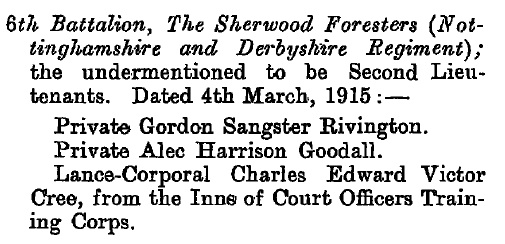
Between the 10th and 18th of May the Battalion dug communication trenches to the west of Foncquevillers.
19th May 1916
On 19th May the Battalion relieved the 6th South Staffs in the centre sector trenches opposite Gommecourt Wood. Headquarters was placed in Foncquevillers, whilst the stores and transport moved to the billets recently vacated in Souastre.
 During the early morning of 27th May the first of what would be many patrols of No-Mans-Land was led by 2/Lt. Kenneth Bond of Rutland Road in Chesterfield. The small patrol spent the day in the abandoned Sucherie on the Foncquevillers to Gommecourt Road, mid-way between the German and British front lines and returned during the evening with a German cap as a trophy.
During the early morning of 27th May the first of what would be many patrols of No-Mans-Land was led by 2/Lt. Kenneth Bond of Rutland Road in Chesterfield. The small patrol spent the day in the abandoned Sucherie on the Foncquevillers to Gommecourt Road, mid-way between the German and British front lines and returned during the evening with a German cap as a trophy.
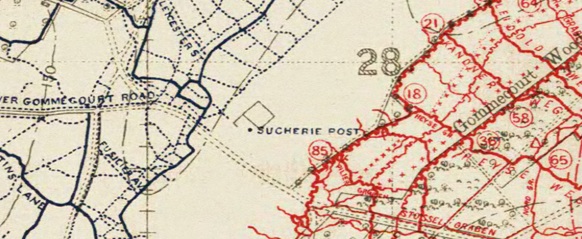 The Battalion were finally relieved by the 8th Sherwood Foresters on 27th May and moved back to Brigade Reserve in Foncquevillers.
The Battalion were finally relieved by the 8th Sherwood Foresters on 27th May and moved back to Brigade Reserve in Foncquevillers.
During the evening of 26th/27th June 1828 L/Corpl Claude Hancock went out into no mans land under heavy fire and brought in two badly wounded men.
During this tour in the trenches 3761 Pte. Lawrence Tuckley and 4216 Pte. James Slater were killed and 18 other men wounded; three of whom subsequently died.
- 3761 Pte. Lawrence George Tuckley aged 22 and a miner from Danesmoor was killed in action on the 20th May. He is Commemorated on the Village Memorial in Danesmoor.

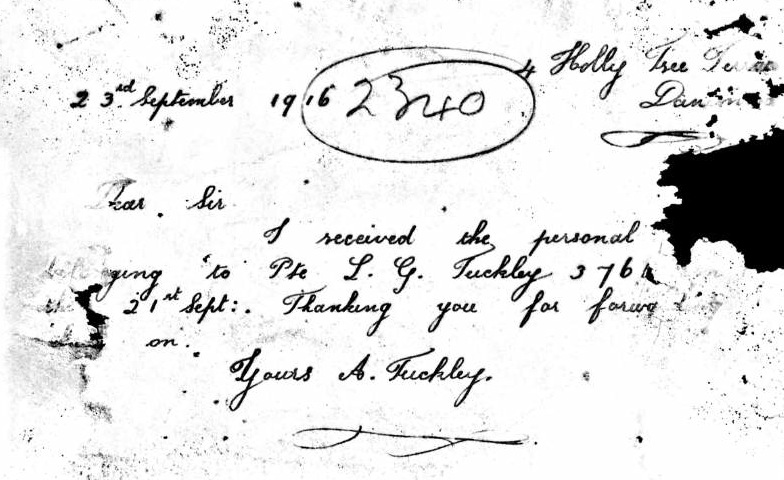 4216 Pte. James Slater from Lincoln was accidentally killed following an accident with a grenade.
4216 Pte. James Slater from Lincoln was accidentally killed following an accident with a grenade.
 Lawrence Tuckley and James Slater are both buried in Foncquevillers Military Cemetery. They were the first men of the 6th Battalion to be buried in this little Cemetery that was to the West of the Village and joined to the front line by Communication Trenches. They would soon be joined by many of their North Midland Comrades.
Lawrence Tuckley and James Slater are both buried in Foncquevillers Military Cemetery. They were the first men of the 6th Battalion to be buried in this little Cemetery that was to the West of the Village and joined to the front line by Communication Trenches. They would soon be joined by many of their North Midland Comrades.
The 3 wounded men who died of their wounds were:-
- 4235 Pte. Harry Straw from New Whittington suffered a shell wound to the head head & abdomen and died of his wounds on the 21st May at the 41st CCS.

- 1924 Pte. Lewis Williams from Clay Cross died of his wounds on the 22nd May at the Base Hospital in Le Havre. He is Commemorated on the Village Memorial at The Church of St Bartholomew in Clay Cross
- 4060 Pte. George Edward Abbott aged 33 and a miner from Whittington Moor who suffered GSW to the chest and legs on the 26th May and died 5 days later at the 41st CCS.
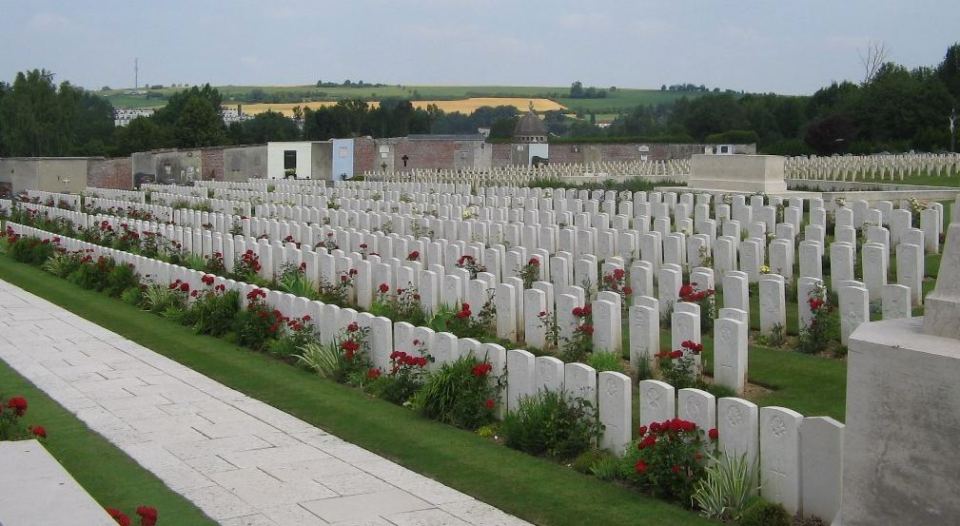 Harry Straw and George Abbott are both buried at Doullens Communal Cemetery Extension No.1 in Plot I, Row D, graves 15 and 21 respectively.
Harry Straw and George Abbott are both buried at Doullens Communal Cemetery Extension No.1 in Plot I, Row D, graves 15 and 21 respectively.
20th May 1916
- 1963 Pte. William Allen a porter from Matlock Bath who was wounded in action but returned to duty the following day.

- 4003 Pte. Herbert Pygall a plate layer from Chesterfield suffered a GSW to the head and eye and was transferred to England and discharged in July 1916.
21st May 1916
- 1552 Pte. Benjamin Stubbins a labourer from Chesterfield who was wounded but remained at duty.
- 2506 Pte. George Waring a half scavenger from Ashbourne.
- 2918 Pte. Arthur Wright.
- 3669 Pte. Edgar Jolley a labourer from New Tupton suffered a GSW in thigh and arm and was transferred to England and discharged in 1917.
- 4447 Pte. George Pearson a miner from North Wingfield suffered a shell wound to the face and was transferred to England. He was later posted to the 29th Battalion and discharged in July 1917.
- 4464 Pte. John Collins arrived in France in 1916 and served with B Company.
24th May 1916
- 2932 Pte. George Mahony arrived in France in February 1915 and served with C Company.
- 2940 Pte. William Bradbury arrived in France in 1916 and served with B Company.
- 3712 Pte. Alfred Thomas arrived in France in 1916 and served with B Company.
- 4455 Pte. Henry Harrison from Stamford in Lincolnshire and arrived in France in 1916.
28th May 1916
- 1897 Pte. Seth Taylor arrived in France in February 1915 and served with A Company.
On the 27th May a draft of 42 men arrived from the 8th Entrenching Battalion and would provide invaluable assistance for the upcoming fatigue duties.
 Army Form B. 103 of 4644 Pte. Walter Green who arrived in France with the 8th Reinforcement on 29th March 1916 and joined the 8th Entrenching Battalion on the 9th April. He joined the 6th Battalion on 27th May 1916.
Army Form B. 103 of 4644 Pte. Walter Green who arrived in France with the 8th Reinforcement on 29th March 1916 and joined the 8th Entrenching Battalion on the 9th April. He joined the 6th Battalion on 27th May 1916.
Whilst in Brigade Reserve the Battalion continued to dig and wire new communication and advanced trenches in preparation for the upcoming attack on the heavily fortified German positions in the Gommecourt Salient.
“About the twenty seventh of June my Battalion was given the task of digging what was known as a Russian Sap, this was a narrow trench leading from our front line towards the German barbed wire, at the time we were not occupying the front line, but were quartered in a small village about three or four miles behind. We paraded about nine p.m. in fighting order, all were issued with shovels, except every sixth man who was issued with a pick. We proceeded through the maze of rear trenches, and through our front line. The troops holding the line wished us luck as we filed past, and as quietly as possible we tried to make as little noise as we could, but it was difficult, what with our rifles, picks, shovels, tin cans, barbed wire and all the things that No-Mans Land could contain to cut out all noise.”
[2305 Frank Longson, DCM]
On the 30th of May a party of 150 men under the command of Captains Saxby and Tolson dug an advanced trench 250 yards long linking up with the 37th Division on the left.
Another party of 85 men under the command of Capt. EB Johnson wired beyond the front line trenches and on the last day of May the 6th Battalion HQ received a message from the GOC 46th Division congratulating them on the splendid work performed on the previous night.
On 3rd June the London Gazzette announced that 2230 Sergt. Matthew Unwin had been awarded the Military Medal for conspicuous bravery in the field.
During the night of 5/6th June the Battalion were relieved by the 5th Lincolns and marched into billets in Humbercamps.
In total the Battalion had spent the last 3 weeks either in the front line trenches or in Brigade Reserve at Foncquevillers.
 The following day a draft or 72 men arrived from base accompanied by two new junior Officers; 2/Lt C.H.C. Cousins and F.R. Oliver. The Battalion now moved to billets at Sus. St. Leger. During this time the Battalion underwent intensive training for the coming offensive; in particular the Battalion bombing section joined the Brigade bombing section for advanced instruction.
The following day a draft or 72 men arrived from base accompanied by two new junior Officers; 2/Lt C.H.C. Cousins and F.R. Oliver. The Battalion now moved to billets at Sus. St. Leger. During this time the Battalion underwent intensive training for the coming offensive; in particular the Battalion bombing section joined the Brigade bombing section for advanced instruction.
Good news for the Battalion arrived on 15th June when the London Gazette announced that a number of Officers and N.C.O.s of the Battalion had been mentioned in dispatchers by the C. in C for gallant and distinguished conduct in the field. These included:-
- Lt Col Goodman
- Capt Cyril Johnson
- 158 CSM Goodard
- 456 CSM HH Holland
- 2388 Sergt T Hunter
- 1464 Sergt Wilfred Longson
- 1644 Drummer Jame Chatterton
During the 18th and 19th June the Battalion again proceeded to Foncquevillers and relieved the 4th Lincolns in support trenches located around the village. The stores and transport moved to La Bazique Farm and safe from German observation. On the following day the 139th Sherwood Forester Brigade practiced an attack near Lucheux Forest in the presence of both the Corps Commander and G.O.C 46th North Midland Division; however, during these manoeuvres the 6th Battalion Sherwood Foresters were placed in support, a position they would subsequently occupy on the opening day of the battle of the Somme.
 Appendix I from the 1/6th Battalion War Diary WO/95/2694 for June 1916.
Appendix I from the 1/6th Battalion War Diary WO/95/2694 for June 1916.
During the night of 23rd/24th and again on the 24th/25th June the final preparations were being completed for the imminent attack and this end the Battalion dug an advanced trench and communication trenches on the Brigade frontage that when completed had a final length of about 1300 yards. These would later act as the jumping off trenches for the 139th Brigade assault and they were clearly visible on aerial photographs taken at the time. However, due to the heavy rain the trench, although linked to the original front line, was not finished in depth.
The digging parties assembled at the head of the Communication Trenches at 10 p.m. and from there they were guided to gaps in the fire trench to commence digging in No-Mans-Land by 10.45 p.m. At 1.45 p.m. the digging and wiring parties returned. During these endeavours the Germans replied with heavy machine gun fire and shelling and Lance Sergeant George Naden from Dove Holes was killed.
- 2211 L/Sergt. George Naden arrived in France on 25th February 1915 and was the eldest son of George and Hannah Naden of Dove Holes. His other brothers Victor (1st Lincolns but formerly 3748 Notts & Derby was k. in a. 25/9/16), Samuel and James also served with the colours.
The Battalion returned to billets on the Gaudiempre-Pas Road and every man was wet through and covered with mud from the digging. The successful completion of this advanced trench warranted a congratulatory telegram from the G.O.C 46th Division; however, in his personal diary an unnamed Officer from Buxton noted that the weather “had resulted in the flooding of a number of trenches which were only passable by swimming” and that it had also caused the attack to be postponed.
The Battalion were finally relieved by the 5th and 7th Battalion Sherwood Foresters and proceeded to draw stores in preparation for the attack on the German trenches.
Foncquevillers Military Cemetery
Many of the North Midlanders are buried in this Cemetery; however, it would appear that there was some renumbering of the graves after the War.
 For example, 5404 Pte. Cyril Charles Harris of the 1/4th Leicester’s who was killed on the 30th June 1916 is now buried in Plot I, Row L and grave 39. However, the report by the Director of Graves Registration that was sent to his next of kin in December 1919 clearly sates that Cyril is buried in Plot I, Row L and grave 94.
For example, 5404 Pte. Cyril Charles Harris of the 1/4th Leicester’s who was killed on the 30th June 1916 is now buried in Plot I, Row L and grave 39. However, the report by the Director of Graves Registration that was sent to his next of kin in December 1919 clearly sates that Cyril is buried in Plot I, Row L and grave 94.








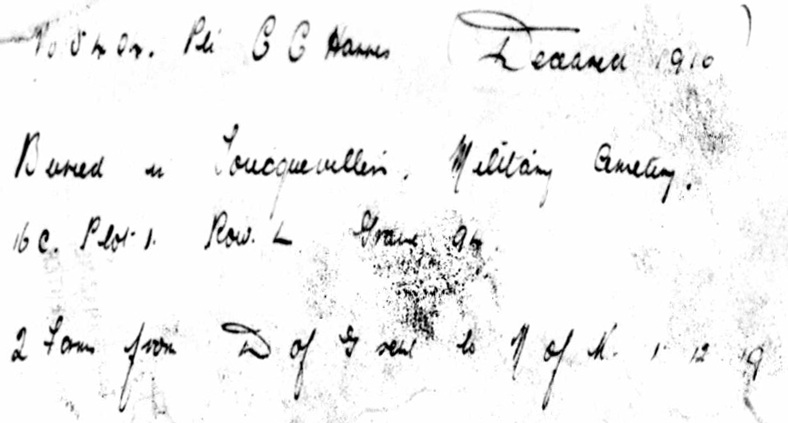
Thanks so much for the history! Just a small correction to the information on the page if I may. My great grandfather was George Edward (Teddy) Abbott 4060, 6th Batt, 5th Platoon, B Company. Teddy was gravely wounded by shrapnel from a grenade on May 20th in the centre trenches at Foncquvillers. He had his right leg amputated at 41st CCS in Doullens on the 24th of May, passing away (probably from infection) on the 26th. His grave is in the Doullens Communal Cemetery, Extension No.1, Plot II, Row C, No.21.
He left behind his wife, Clara, and daughters Lily, Gladys, Clara, Emily, and Florence Abbot (Florence being a 6 week old baby that Teddy never met).
When we cleared my Grandma’s Gladys’ house in Chesterfield after her passing, we found a bundle of 82 letters sent to Clara by Teddy from France, and also my Great Grandmother’s last several letters to Teddy which I assume must have been returned to her with his other personal possessions.
Many thanks – how very poignant and interesting. I’ll make sure to correct the entry.